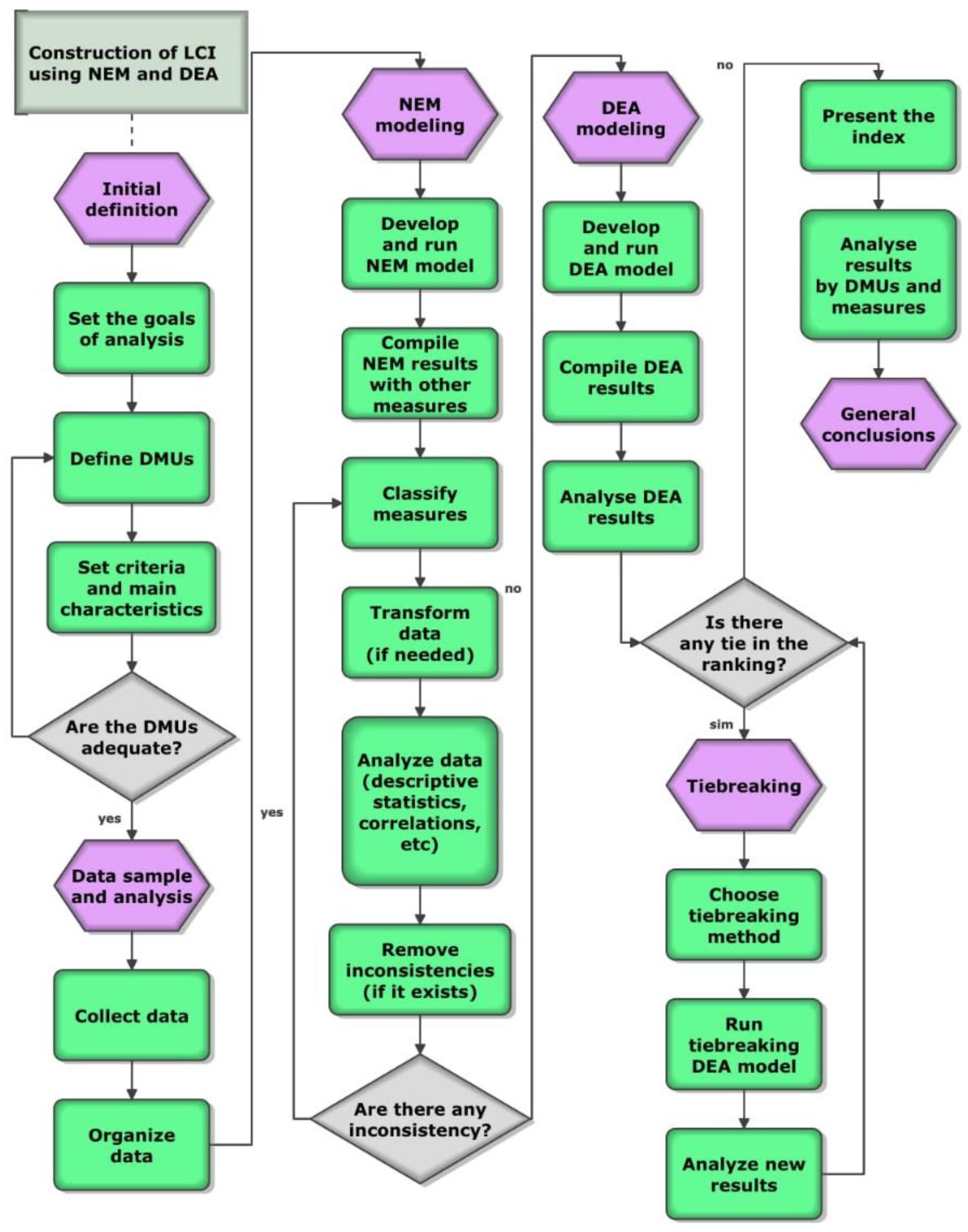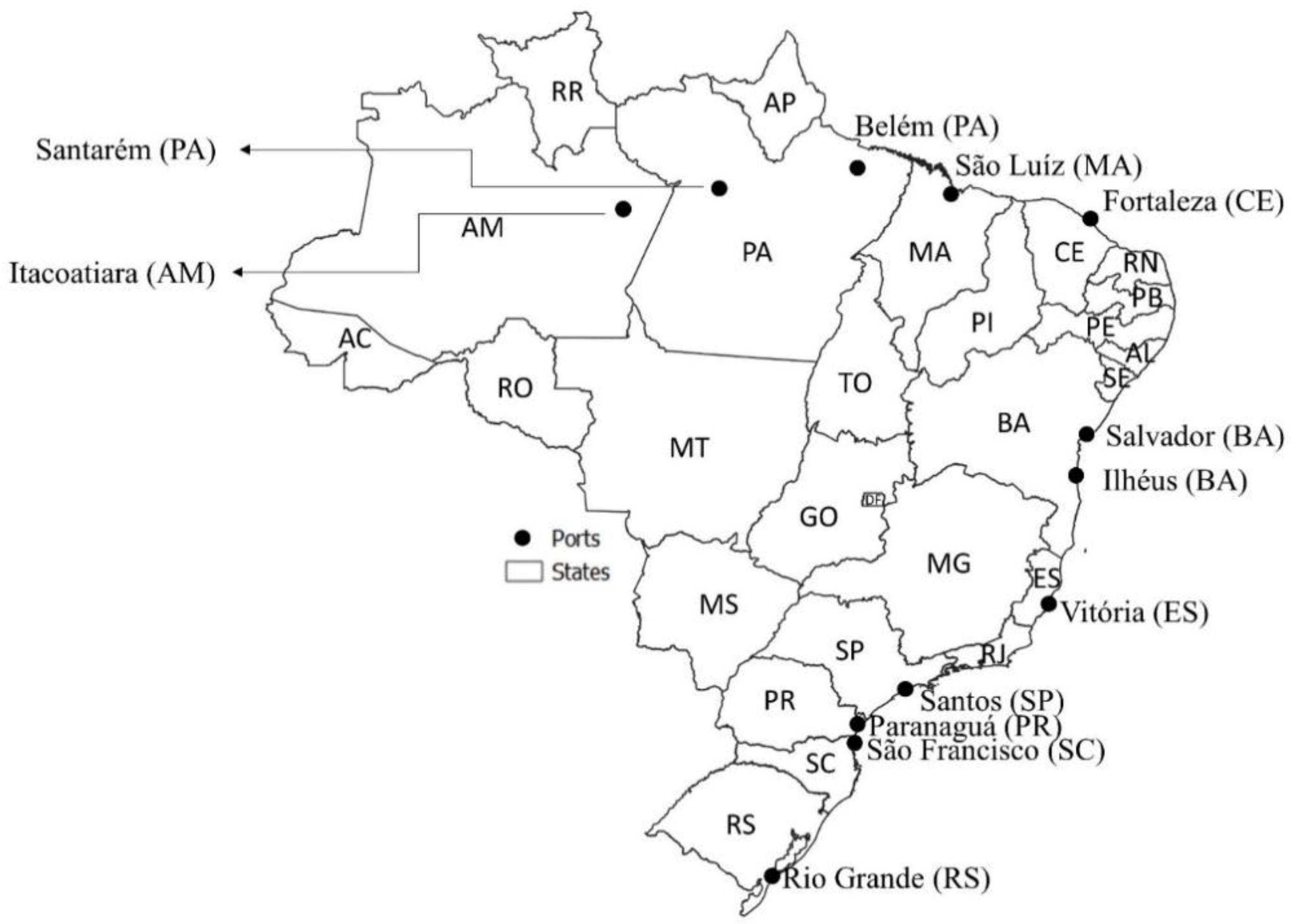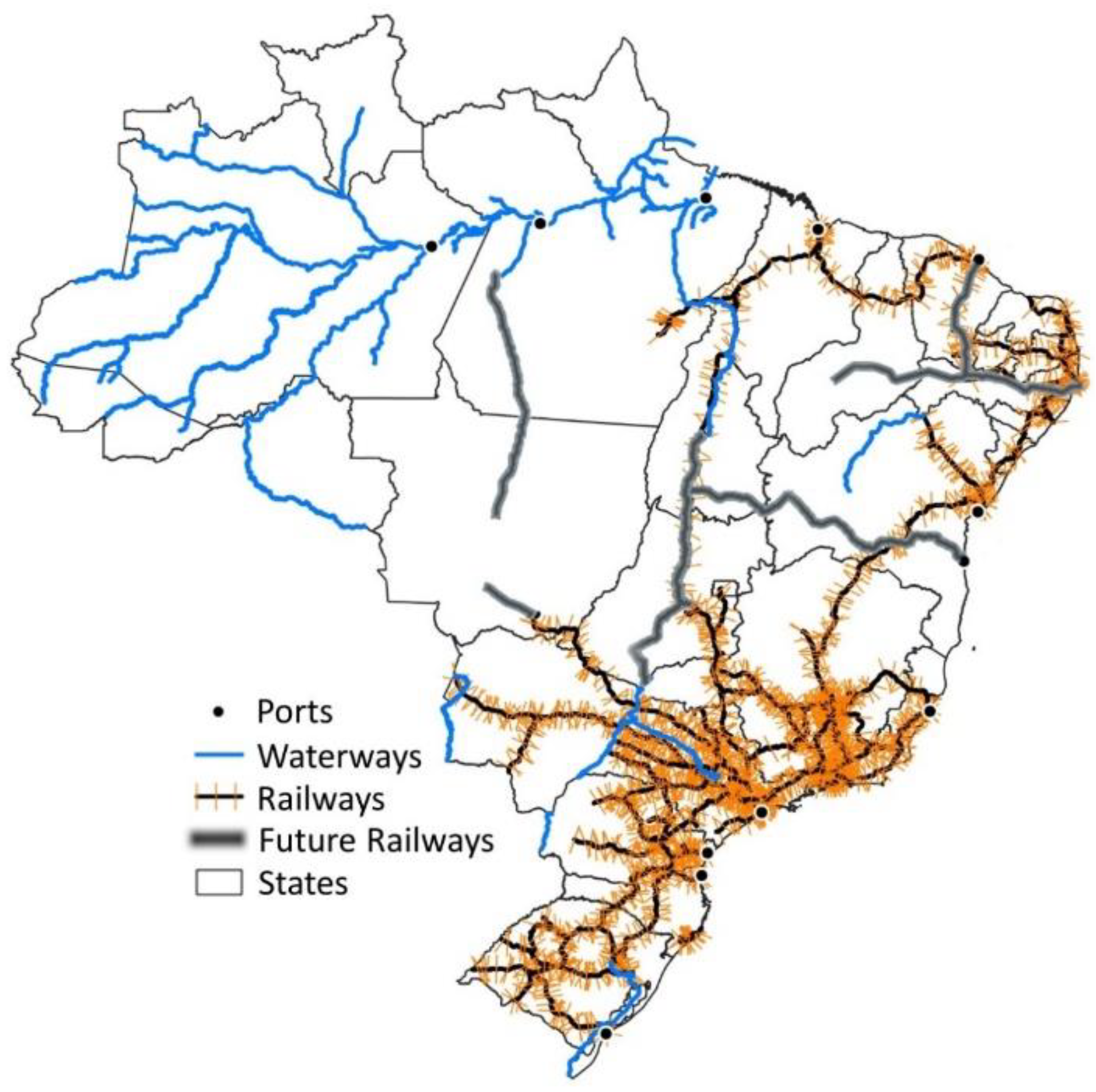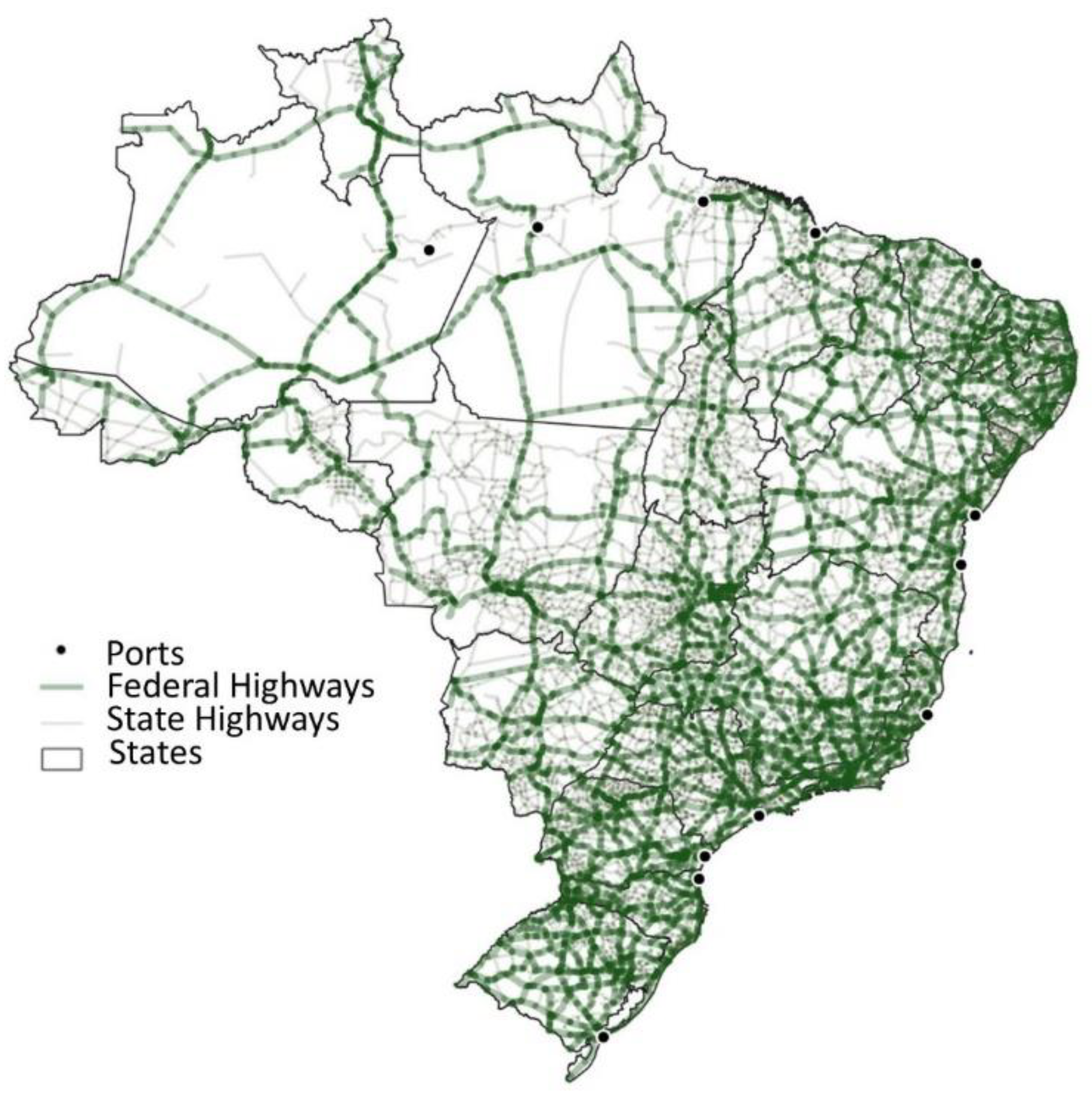2.1. Formulation of Network Equilibrium Model (NEM)
The NEM was used to assign the optimal distribution of soybean and corn production and the transportation flows between production and demand regions into the multimodal transport network, aiming at minimizing total cost and calculating the CO2 emissions generated by the transportation flows. Also, the impact of the planned railways on the transport flows was evaluated.
The model structure is similar to [
12] and it is presented in Equations (1)–(6). The objective function of the model is defined by Equation (1) and it minimizes the transportation cost (
) of supplying soybean and corn to domestic demand regions and export terminals. The solution is constrained by transportation capacities, supply and demand levels, and conditions of the Brazilian soybean and corn supply chain. These constraints are presented in Equations (2)–(6).
The constraint in Equation (2) defines that the total quantity of soybeans and corn shipped to supply domestic demand and exports must be lower or equal to the production (of each product in the origin region .
Ensuring the supply of domestic demand (), Equation (3) states the total amount of products moved to each demand region must be equal to the domestic demand ( for each product in that region.
The equality constraint in Equation (4) guarantees that the total amount of each product moved to each destination node is addressed as exporting terminal ( is equal to the international demand ().
The equality constraint in Equation (5) guarantees that the transportation flows arriving in each transshipment terminal must be equal to the transportation flows that are departing from that terminal.
Equation (6) is related to the limitation of the total quantity of cargo assigned to each transshipment terminal
and it must be equal to or less than the load capacity of that terminal, represented by
. The complete model structure is similar to [
12] and it can be seen as follows in Equations (1)–(6).
Subject to:
where C: Total transportation cost (
).;
: Transportation cost rate (US
$/ton of cargo) from origin to destination (
, from origin to transshipment terminal (
, and from transshipment terminal to destination (
;
: Road transportation flow of product
between origin
and destination
, in market
;
: Road transportation flow of product
between origin
and transshipment point
, in market
;
: Multimodal transportation flow of product
between transshipment point
and destination
, in market
;
: Production of each product
and origin region
;
: Domestic Demand of product
in the domestic destination
;
: Exportation of product
in the port destination
;
: Total load capacity of the transshipment terminal t;
: domestic market;
: international market;
set of destinations classified as export terminals.
After applying the NEM model, the routes were aggregated (i.e., the routes used to move more cargo have a greater weight in a weighted average) to define the corridors and apply DEA to evaluate its performance.
2.2. Formulation of Data Envelopment Analysis (DEA) Model
The DEA is a non-parametric method that can be applied to measure the efficiency of Decision-Making Units (DMUs) in systems with multiple inputs and multiple outputs, and with different units of measurement. Besides, DEA can also be used for constructing a performance Composite Index (CI) in general, where the outputs are indicators to be maximized and the inputs are indicators to be minimized [
33]. The formulation of the models change regarding the orientation (input, output, or non-oriented), assumptions of Variable Returns to Scale (VRS) or Constant Returns to Scale (CRS), among other characteristics [
34,
35].
In this paper, the DMUs are the transport corridors considered in the performance analysis, from corn- and soybean-producing regions to each export port. For measuring the performance of a set of DMUs, each DMU is normally associated with characteristics measures classified in, at least, inputs or outputs. For multi-criteria application, inputs can be understood as “the least, the best” and outputs as “the most, the best”—for the benefit of efficiency [
33].
Some prerequisites are necessary for DEA modeling. According to Cooper et al. (2007) [
36], considering a high number of measures in the model can diminish the discriminant level of the model, and it is possible (but it will not necessarily happen) to obtain many tied efficient DMUs, so the authors’ guide is that the number of DMUs being higher than three times the sum of the number of measures. In this paper, we collected data from seven measures, from 24 DMUs, respecting this prerequisite.
According to Dyson et al. (2001) [
28], another prerequisite in DEA modeling is the homogeneity of the DMUs. For example, if the DMUs are homogeneous, they make similar activities, comparable products, or services, and a common set of measures can be defined to all DMUs. In this paper, the DMUs are the corridors, from origins to export ports.
According to Golany and Roll (1989) [
37], the “isotonicity” between inputs and output is assumed when using DEA. Thus, increasing input values may lead to increasing output value (but not the opposite). Their relationship was tested by applying Kendall’s Tau ordinal correlation coefficient (
Table 1).
Observing
Table 1, it is possible to verify that all inputs (DI or UI) are significate and positively correlated to at least one output (DO or UO). EXPORTS is correlated to the DEPTH and STORAGE (that possible means that the routes and corridors with more storage and have ports with deeper depths attract more cargo to export). ACCIDENTS is correlated to PAVED. This possibly means that the routes and corridors with more paved highways attract more truck flows, resulting in more accidents because highways have the highest quantities of accidents among the modes. CO
2 is correlated to PAVED and COSTS. This possible means that the routes and corridors with more COSTS are possibly also the ones with higher distances, resulting in more CO
2, but at the same time, the only significant and negative correlation is with paved highways, possibly because the long-distance routes and corridors use less paved highways, while the opposite is true for the short-distance ones. Thus, the other correlations are not significant, and the authors found the unique significant negative correlation justifiable.
Among the DEA models, the SBM (a model previously applied for agricultural and logistic problems [
3]) simultaneously minimizes inputs and maximizes outputs without requiring the selection of orientation, resulting directly in a rank of DMUs based on their efficiencies [
29]. Subsequently, the CI tiebreaking method was applied [
38]. It is a double-frontier method represented by an arithmetic average between standard and inverted efficiencies. This arithmetic average is standardized by the maximum value of the analyzed set of DMUs, resulting in the composite index.
The formulation of the SBM model [
29] is as follows in Equations (7)–(11):
where
: Efficiency,
: Model linearization variable,
: Slack of the ith input,
: Slack of the jth output,
: Contribution of the kth DMU to the analyzed DMU,
: ith input of the DMU under analysis,
: jth output of the DMU under analysis,
: ith input of the kth DMU,
: jth output of the kth DMU,
: Number of inputs,
: Number of outputs,
: Number of DMUs.
The standard models are formulated considering desirable outputs (O) (to be maximized), and desirable inputs (I) (to be minimized), but in real situations, there are undesirable outputs (UO) (to be minimized) and undesirable inputs (UI) (to be maximized) [
39]. The simplest approaches to deal with UO and UI are based on treating UO as an output with negative effect (i.e., mathematically it is an output behaving as an input, so, in a post-efficiency analysis, the goal is to decrease the UO) and UI as an input with positive effect (i.e., mathematically it is an input behaving as an output, so, in a post-efficiency analysis, the goal is to increase the UI), or by data-transformation, but this second approach can lead to adverse results [
39].
The Slack-Based Measure also allows the Variable Returns to Scale (VRS) or Constant Returns to Scale (CRS) assumption [
29]. According to Cook et al. (2014) [
33], mixing raw data with ratios is permissible in DEA, but the VRS assumption is preferable, mainly when the ratio data is in percentages because considering CRS assumption not always maintain the projection between 0% and 100%. The model from this paper is under the VRS assumption, considering the incorporation of UO and UI [
39] and the VRS assumption. The model is formulated as follows in Equations (12)–(19) [
39]:
where
: Efficiency,
: Model linearization variable,
: Slack of the ith input,
: Slack of the
-th UI,
: Slack of the jth output,
: Slack of the
-th UO,
: Contribution of the kth DMU to the analyzed DMU,
: ith input of the DMU under analysis,
: jth output of the DMU under analysis,
: ith input of the kth DMU,
: jth output of the kth DMU,
: the
-th UI of the kth DMU,
: the
-th UO of the kth DMU,
: Number of inputs,
: Number of UI,
: Number of outputs,
: Number of UO, and
: Number of DMUs. A DMU will be deemed as efficient when
.
Also, the CI tiebreaking method was applied [
38], according to Equation (20).
where
: Standard efficiency of the kth DMU,
: Inverted efficiency of the kth DMU (i.e., the efficiency handling inputs as outputs and vice-versa).
The ranking resulting from this modeling in Equation (20) was the final ranking used to evaluate the GTCs (further explanations in the results section).
2.3. Data Sample and Empirical Application
The NEM modeling considered two kinds of transportation flows. One was composed of only highways from the origins directly to the ports (deemed “road routes”), and the other one was composed of highways from the origins to transshipment terminals, and continuing from railways or waterways terminals to the ports (deemed “multimodal route”). The current application considered two scenarios of the Brazilian transport infrastructure: Scenario 1) Only the current network of roadways, railways, waterways, and export ports; Scenario 2). The previous scenario plus the planned railways. The interregional transportation flows resultant from the modeling were aggregated into 12 export corridors (according to the export ports).
Each corridor is an aggregate of routes, from diverse corn- and soybean-producing regions (origins) to each port (destination). For example, suppose only five routes were analyzed. Three of the routes had their origins in different grain-producing locations from the Center-West region and they exported to the same port from the Northeast region. So, they would be aggregated by their importance (i.e., the routes used to move more cargo have a greater weight in a weighted average), creating the corridor from the Northern arc of the country. In parallel, suppose the other two routes had their origins in different grain-producing locations from the Southeast region, and they both exported to the same port from the Southern region. In this way, they would also be aggregated (i.e., the routes used to move more cargo have a greater weight in a weighted average), creating the corridor from the Southern arc of the country.
In practice, the DEA was applied jointly to a sample with all corridors, for comparing 24 corridors (12 corridors from each scenario) and measuring the performance of these corridors. The maps in
Figure 2,
Figure 3 and
Figure 4 show the multimodal transport network in the main soybean export corridors.
The 12 export ports (
Figure 2) of the transport corridors are: Itacoatiara (AM), Santarém (PA), Belém/Barcarena (PA), São Luís (MA), Vitória (ES), Santos (SP), Paranaguá (PR), São Francisco do Sul (SC), Rio Grande (RS), Fortaleza (CE), Salvador (BA), and Ilhéus (BA).
The main current railways considered in Scenario 1 (
Figure 3) are: Rumo (Malhas Oeste, Sul, and Paulista), Rumo Malha Norte (not entirely finished yet), Estrada de Ferro Paraná-Oeste, Ferrovia Tereza Cristina, Estrada de Ferro Carajás, Ferrovia Transnordestina, Ferrovia Centro-Atlântica, Estrada de Ferro Vitória-Minas, MRS, and Ferrovia Norte Sul (not entirely finished yet) [
42].
The planned railways (for 2025 according to Planning and Logistics Company [
41]) considered in scenario 2 (
Figure 3) have received positive attention from the Brazilian government and private agents [
40,
41,
42] and are listed below.
- (1)
Ferrograo (FG): this railway will connect Lucas do Rio Verde (MT) to Miritituba (PA) providing access to the Tapajós waterway which offers a barge transport alternative, currently in operation for exports through Port of Santarém (PA). The budget for this project predicts that investments of US$13,290 billion are needed for the construction of 933 km of the railway.
- (2)
Ferrovia Norte-Sul (FNS): this railway will connect Palmas (TO) to Estrela D’Oeste (SP) and will provide rail access to both Port of Santos (SP) and Port of São Luís (MA). The project’s budget predicts an amount of US$2772 billion that will be needed for the implantation of 1534 km.
- (3)
Ferrovia de Integração Oeste-Leste (FIOL): this railway will connect the Bahia West region to Port of Ilhéus (BA). The construction of 1022 km of the railway will request investments totaling US$1650 billion.
- (4)
Ferrovia Rumo Malha-Norte (RMN): this project aims to extend the Railway Rumo Malha-Norte from Rondonópolis (MT) to Cuiabá (MT) and this railway provides access to Port of Santos (SP).
- (5)
Ferrovia Nova Transnordestina (NTN): this project will connect Eliseu Martins (PI) to Port of Pecém (RE) and Port of Suape (CE). The latest estimative is a total of US$1740 billion for the construction of 1753 km.
Finally, the main waterways (
Figure 3) of the transport corridors are Madeira River, Amazon River, and Tapajós River in the states of the Center and North regions of the country, and the Waterway of the Tietê-Paraná River in the Center and South regions of Brazil. At last, the main Brazilian states and federal highways of the transport corridors are shown in
Figure 4.
In the current DEA modeling, seven measures (
Table 2 and
Table 3) were considered and treated as follows:
- -
Output (O): the amount of exported soybeans and corn by each port (10
3 tons) (EXPORTS). The EXPORTS were collected in SECEX-SISCOMEX [
43]. The total sum of exports was about 107 million tons of grains, and the exports per kind of product considered in this research were about 83.5 million tons of soybean and 23.5 million tons of corn [
43].
- -
Undesirable Inputs (UI): the highest draft depth of each port (meters) (DEPTH), the grain storage capacity in the catchment area (10
3 tons) (STORAGE), and the paved road density (10
2 km of road/km2 of the area) of the export port catchment area (PAVED). The DEPTHs were collected in the National Waterway Transport Agency (Antaq) [
44], the STORAGEs, in the Brazilian Institute of Geography and Statistics (IBGE) [
45]. The PAVED highways were collected in the National Land Transportation Agency (ANTT) [
46] and the National Department of Transport Infrastructure (DNIT) [
47].
- -
Input (I): the weighted average freight cost of the flows arriving in each export port (BRL/ton) (COSTS). The COSTS were obtained in the database from the ESALQ-LOG group, the official Brazilian institution for agriculture logistics data [
48].
- -
Undesirable Outputs (UO): the weighted average CO
2 emission (kg of CO
2/ton) (CO
2) and the number of accidents per kilometers estimated in the transportation corridor (accidents/km) (ACCIDENTS) [
49,
50,
51].
It is worth noting that the CO
2 emission is a common measure for modeling environmental aspects in this context and it was computed based on the results from NEM (distances, fuel consumption, and the amount of CO
2 emitted by the fuel consumed) [
3,
31]. The distances were obtained in the software Transcad. The diesel consumption by road transport mode was 14.2 L per 10
3 ton.km, obtained in the database from the ESALQ-LOG group [
48], and by water transport mode was 5 L per 10
3 ton.km, obtained in the document about the Tietê-Paraná Waterway from Antaq [
52]. The CO
2 emission coefficients by rail transport mode was 0.021 kg CO
2/km [
53], by water transport mode were 2.591 kg CO
2/liter of diesel and 0.013 kg CO
2/km, and by road mode were 2.591 kg CO
2/liter of diesel and 0.037 kg CO
2/km [
12].
The social aspect of accidents is more rarely used due to, among other factors, the scarcity of data [
3]. The ACCIDENTS were estimated based on highways, railways, and waterways accidents and the total distances. The accidents from highways were collected in National Transportation Confederation [
49]. The accidents from railways were computed based on the accidents per train.km, on the movement of trains in rail freight transportation in train.km, and on the distance in km. The data was collected from the Land National Transportation Agency—ANTT [
50]. Thirdly, the accidents in waterways were estimated based on the last year of the study in Naval War School and EZUTE [
51].
Table 2 summarizes the variables, their DEA classifications, descriptions, and sources.
Following the recommended approach from previous authors [
31,
39,
54] and Equations (12)–(19), the UIs were inserted in the model as Os to be maximized and the UOs, as Is to be minimized.
The aggregation of routes was calculated as a weighted average value for the corridor (or summing in the case of EXPORTS). The data is presented in
Table 3. It is worth noting that the data refers to the harvest year of 2018/2019.











